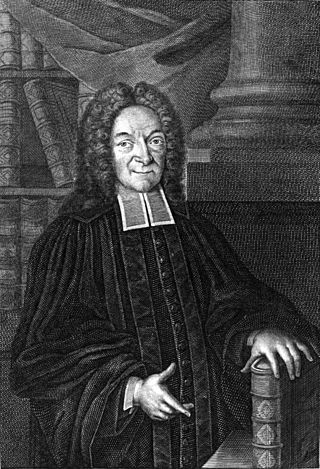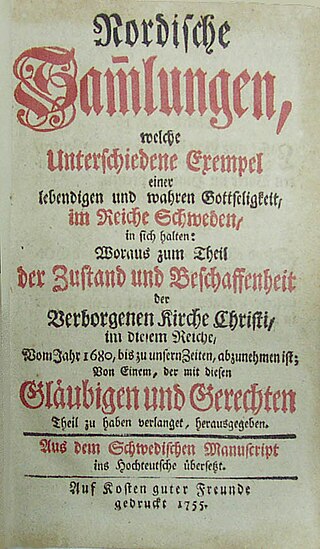Related Research Articles
Pietism, also known as Pietistic Lutheranism, is a movement within Lutheranism that combines its emphasis on biblical doctrine with an emphasis on individual piety and living a holy Christian life.

Johann Arndt was a German Lutheran theologian who wrote several influential books of devotional Christianity. Although reflective of the period of Lutheran Orthodoxy, he is seen as a forerunner of Pietism, a movement within Lutheranism that gained strength in the late 17th century.

The Catholic Church in Sweden was established by Archbishop Ansgar in Birka in 829, and further developed by the Christianization of Sweden in the 9th century. King Olof Skötkonung is considered the first Christian king of Sweden.

The Diocese of Gothenburg is a diocese of the Church of Sweden. Since March 2018, the bishop has been Susanne Rappmann. The diocese includes the provinces of Bohuslän, Halland, and south-west parts of Västergötland. The episcopal see of the diocese is in Gothenburg Cathedral.
High church Lutheranism is a movement that began in 20th-century Europe and emphasizes worship practices and doctrines that are similar to those found within both Roman Catholicism, Eastern Orthodoxy and the High church wing of Anglicanism. In the more general usage of the term, it describes the general high church characteristics of Lutheranism in the Nordic and Baltic countries such as Sweden, Finland, Estonia and Latvia. The mentioned countries, once a part of the Swedish Empire, have more markedly preserved Catholic traditions.
Lutheranism as a religious movement originated in the early 16th century Holy Roman Empire as an attempt to reform the Roman Catholic Church. The movement originated with the call for a public debate regarding several issues within the Catholic Church by Martin Luther, then a professor of Bible at the young University of Wittenberg. Lutheranism soon became a wider religious and political movement within the Holy Roman Empire owing to support from key electors and the widespread adoption of the printing press. This movement soon spread throughout northern Europe and became the driving force behind the wider Protestant Reformation. Today, Lutheranism has spread from Europe to all six populated continents.

Valentin Ernst Löscher was a German orthodox Lutheran theologian.

Radical Pietism are those Christian churches who decided to break with denominational Lutheranism in order to emphasize certain teachings regarding holy living. Radical Pietists contrast with Church Pietists, who chose to remain within their Lutheran denominational settings. Radical Pietists distinguish between true and false Christianity and hold that the latter is represented by established churches. They separated from established churches to form their own Christian denominations.

Fredrik Gabriel Hedberg was a Finnish Lutheran pastor and vicar. He was a Neo-Lutheran theologian, a prominent figure in the Finnish evangelical revival movement and a leader of confessional Lutheranism in Finland.

Spaak is a family originating from Bohuslän, Sweden, with notable branches in Belgium, France, and Italy.
Swedish Baptists are Baptists that trace their origins to Radical Pietism, the Mission Friends movement, and the Pietist or Pietistic Lutheran tradition of Lutheranism.

The Eastern Cemetery is a cemetery in Uddevalla, Sweden. It belongs to the Church of Sweden, which professes to Lutheranism, and serves as burial grounds for – primarily – the members of Bäve Parish.
The Conventicle Act was a Swedish law, in effect between 21 January 1726 and 26 October 1858 in Sweden and until 1 July 1870 in Finland. The act outlawed all conventicles, or religious meetings of any kind, outside of the Lutheran Church of Sweden, with the exception of family prayer or worship. The purpose was to prevent freedom of religion and protect religious unity, as such unity was regarded as important to maintain the control of the Crown over the public through the Church. The law only applied to Swedish citizens, while the religious freedom of foreigners was protected by the Tolerance Act.

Jonas Patrik Ljungström was a Swedish cartographer, geodesist, and teacher at the Royal Institute of Technology.

Bagge is a Swedish family originally of Norwegian background from Marstrand, Bohuslän, by Nils Fredriksson Bagge, burgher and mayor of Marstrand in the 17th century. According to Danmarks Adels Aarbog, the yearbook of the Danish Nobility, ennobled Sea Captain Peder Bagge was issued from the family.
Johan Patrik Ljungström (1784–1859) was a Swedish jeweler, inventor, and underwater diving pioneer. He is credited as the first private underwater diver in Sweden, and possibly beyond.
The Conventicle Act was a decree issued 13 January 1741 by King Christian VI of Denmark and Norway and forbade lay preachers from holding religious services – conventicles – without the approval of the local Lutheran priest. The law was repealed in 1839 in Denmark and 1842 in Norway, which lay the groundwork for freedom of assembly.

Peter Lorenz Sellergren was a Swedish Lutheran priest, theologian, and gammalkyrklig revivalist preacher.
The Mission Friends was an interdenominational Christian, mostly Pietist and Radical Pietist association in Sweden and among Swedish Americans in the United States, that eventually had an impact on several Protestant denominations and their missionary societies today, even outside of Lutheranism, the Swedish community, and the United States, eventually influencing other communities and forming new independent Radical Pietist, Baptist – especially Swedish Baptist – and later on Pentecostal and Charismatic free church denominations.
Jacob Otto Hoof was a Swedish Lutheran priest and Christian revivalist preacher.
References
- ↑ "Kyrkohistorisk årsskrift". 1900.
- 1 2 "251 (Religionstvång och religionsfrihet i Sverige 1686-1782. Bidrag till den svenska religionslagstiftningens historia)". runeberg.org. 14 September 1896. Retrieved 14 September 2018.
- ↑ "Jacob Benzelius". sok.riksarkivet.se. Retrieved 14 September 2018.
- ↑ "De egensinniga svartrockarna i Thorilds hemtrakter | Red Viking: Reseguider i Bohuslän". redviking.se. Archived from the original on 2015-05-10.
- ↑ "Carl August Kullgren". sok.riksarkivet.se. Retrieved 14 September 2018.
- ↑ "Om oss - Evangeliska Brödraförsamlingen" . Retrieved 14 September 2018.
- ↑ Uddevalla Missionsförsamlings 100-årsskrift (1978)
